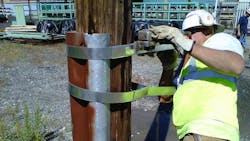Wood Pole Inspection and Replacement Continues at Potomac Edison
To help enhance the reliability of its electric system, Potomac Edison crews have replaced or repaired about 1,000 wooden utility poles so far this year as part of the company's annual inspection program.
Overall, Potomac Edison expects to spend approximately $2.1 million in 2014 inspecting more than 23,000 of its nearly 400,000 wood poles for signs of wear, insect infestation, or damage from a car accident.
A standard 40-foot wooden distribution pole typically is expected to last more than 50 years. The most common utility pole is made from a Southern Yellow Pine tree and costs about $400.
"Wooden utility poles form the backbone of our distribution network that delivers electricity to the homes and businesses throughout Potomac Edison's service area. We expect to replace or repair about 1,200 poles by the end of the year as part of our ongoing efforts to enhance service reliability for our customers," said James A. Sears, Jr., president of FirstEnergy's Maryland operations and vice president of Potomac Edison. "While certainly durable, these poles are in the elements 365 days of the year and subject to damage from severe weather, falling trees, and traffic accidents. Over time, some poles need to be replaced to help ensure our system remains reliable and resilient."
Typically, specialized contractors perform the pole inspections. As part of the process, a visual inspection is completed, along with checking the pole to determine if the interior is sound. Poles also can be reinforced rather than replaced. One of the most common reinforcement techniques is to snug a C-shaped steel beam against the pole, jackhammer the beam into the ground, and secure it to the pole with tight, metal bands.
All wood poles throughout Potomac Edison's service territory in Maryland and the Eastern Panhandle of West Virginia are inspected on 10-year and 12-year cycles, respectively. Inspections began in January and will continue through summer, with pole replacements and repairs scheduled to be completed during the fall.
Year-to-date, Potomac Edison has inspected about 21,500 wooden poles in and around the following communities:
- Cumberland – 2,354 (poles inspected)
- Falling Waters – 2,543
- Frederick – 2,535
- Martinsburg – 3,919
- Mt. Airy – 2,769
- Oakland – 1,744
- Williamsport – 5,578
